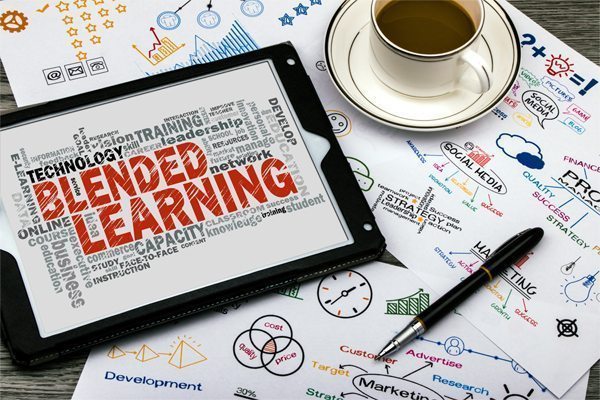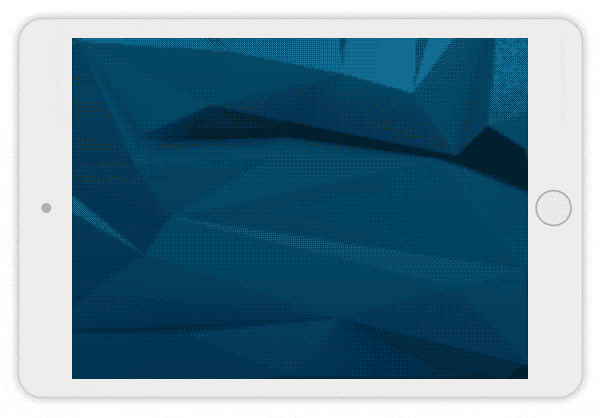
Blended Learning: Why It’s Taking The Lead In Education
We have all used different methods of ‘blended learning’ models when being educated in our classrooms and trained in the workplace. Whether we realized it or not, blended learning has been incorporated in most institutions and companies through various technology platforms designed to enhance the learner’s needs since the term was coined in the late nineties. Learn more about blended learning in this full guide.

What is Blended Learning?
Although the term is quite ambiguous, it can extensively be defined as: ‘any formal education program in which a student learns at least in part through online learning, with some element of student control over time, place, path, and/or pace’ (Blended Learning Universe, 2016). Children are born into this digital world and are already exposed and using technology as early as the age of 1. According to a study presented at the 2015 U.S. Pediatric Academic Societies Annual Meeting, more than one in three children have used a smartphone or tablet device before the age of one meaning that children today are more tech-savvy than ever before. The development of blended courses has been based on a strategy that encourages the use of technology along with face-to-face instruction. Studies predict that by 2019, 50% of high school courses will be available and delivered online. The blended learning approach is flexible in presenting content, has proven potential to enhance the effectiveness and efficiency of learning experiences, and is personalized making it easier for students to contribute and learn at their own pace. It is not surprising that blended learning methods
Children are born into this digital world and are already exposed and using technology as early as the age of 1. According to a study presented at the 2015 U.S. Pediatric Academic Societies Annual Meeting, more than one in three children have used a smartphone or tablet device before the age of one meaning that children today are more tech-savvy than ever before.
The development of blended courses has been based on a strategy that encourages the use of technology along with face-to-face instruction. Studies predict that by 2019, 50% of high school courses will be available and delivered online. The blended learning approach is flexible in presenting content, has proven potential to enhance the effectiveness and efficiency of learning experiences, and is personalized making it easier for students to contribute and learn at their own pace. It is not surprising that blended learning methods are benefiting as an integrated learning experience throughout the U.S.
Horn and Staker (2015) define Blended Learning as “…any formal education program in which a student learns at least in part through online learning, with some element of student control over time, place, path, and/or pace.”
The approach of blended learning is to utilize the use of technology in the classroom to optimize student education through online and face-to-face interaction. The usage of blended learning gives us an opportunity to reform the traditional school model and to express student-centered learning.
How does Blended Learning Work? What is being ‘Blended?’
When educators implement a new learning program, it is important to recognize the learners’ needs and abilities in order to make learning a meaningful and emotional experience.The complexity of our neural networks allows us to have unique individual preferences and learning styles. Blended Learning can be applied right in the traditional setting of a classroom.
Depending on the teacher, different models are used to support the use of technology to expand learning materials and discussion both inside and outside of the classroom. A true ‘blend’ of instruction uses elements that help students and teachers communicate inside and outside of the classroom. Using digital tools for learning such as Google Docs and Word do not necessarily apply to this method.
Instead, blended learning is an integrated learning experience that provides modules to blend the course of study with a teacher being active in the process. An example would be students attending class face-to-face and then go home to have a virtual meeting lecture on the computer and coming back the next day to discuss everything in small groups during a lab.
There is almost always a type of tracking system implemented on the site to track students’ progress. Sometimes it is easy to confuse the blended learning method with a “technology-rich” classroom. Both share the usage of technology and digital tools but are certainly not the same thing. Teachers using only digital textbooks, learning apps, online lesson plans, and Google Docs do not qualify as the blended learning curricula. Students must have some type of control at their own pace for individualized learning. Presently, blended learning does not have one main authority definition. The combination of intellectual methods are made up of information technology, video conferences, and the use of online activities and learning support systems such as self-paced lessons.
Six common models being used today are explained below.
What are the Types of Blended Learning Models?
There are six standard models of blended learning used for teachers. Three models address the different cognitive and social-emotional abilities of students. The six types are identified as:
- Face-to-Face Driver is represented as the most traditional by having a physical teacher present or to employ online learning.
- Rotation means that students will alternate between self-paced online learning and being in the classroom with a teacher. This model includes four sub-models: Station Rotation, Lab Rotation, Flipped Classroom, and Individual Rotation. In the ‘flipping’ method, professors and teachers use online media to deliver lectures, notes, and feedback. Students can study and review the material at their own pace. The model is implemented with a student-centered perspective which allows students to learn individually.
- Flex is the online platform used.
- Online Lab delivers the course in a brick-and-mortar (traditional) setting.
- Self-Blend model, more commonly known as A La Carte, gives students the freedom to choose remote online courses to supplement their school’s curriculum with something that is more individual. The students can take multiple courses either entirely online at home or in a regular classroom.
- Online Driver program is also known as Enriched Virtual is used completely online where students can divide their time between a traditional classroom and at home. Unlike the Flipped classroom, the Online Driver does not require daily school attendance. Teachers can apply their programs to have available or mandatory face-to-face check-ins. The Enriched Virtual program is a complete blend of online and brick-and-mortar classroom sessions.
How Does Blended Learning Differ from Traditional Learning?
The rise of blended learning programs represents a shift from traditional instruction in education to optimize student learning in multiple ways. The mixture of this learning experience has allowed learners to recall information so that it can be remembered and combined with new knowledge bases.
Personalized learning is excellent for students who feel lost and overwhelmed in the classroom. The old brick-and-mortar classroom with students learning from one textbook is long, long gone. Blended learning methods help students learn at their own cognitive level of functioning. The Face-to-Face Driver model works best in all classrooms since most students are functioning at different levels of ability. Teachers deliver this model appropriately by allowing a traditional classroom experience and integrating technology. Students who do not feel confident in their work can access the course from home and study at their own pace while students who have mastered the subject can practice and challenge themselves more effectively.
The Rotation model is the most common and allows teachers to switch instructing online and physically face-to-face. Students can be separated based on skill level such as starting instruction in-person before rotating online. More individual assistance is also given to students feeling left behind on a topic. Another model that is viewed as highly successful is the Online Lab school model. It involves students going to a physical classroom that only provides online educational delivery for its courses. The Online Lab is flexible and benefits students who have other responsibilities either at home or they need to move at a much slower pace than traditional classrooms provide. One of the main goals of a blended classroom involves the mission to capture the learners’ attention.
Many instructors design their teaching to acquire the use of both long-term memory and short-term/working memory. Working/short-term memory has to do with what you are actively doing at the moment and temporarily storing information, such as solving math problems. Long-term memory helps us remember rules and knowledge that is ‘declared.’ An example of declared memory would be having the order of operations memorized. In virtual classrooms, instructors must make sure there is harmony between working and long-term memory. An information overload in a blended approach can cause anxiety and stress. It is important for instructors to design their programs with a few facts in mind:
- Humans have a working memory limited to five to seven ‘chunks’ of information
- Humans must have their attention refreshed frequently
- Recalling information requires more cognitive effort than recognizing information (Marchionini, 1991)
Teachers can add more drop-down menus, touch panels, and clearly marked buttons to put the students’ minds at ease. More information on some challenges of blended learning can be found in the Research in Learning Technology journal. E-learning specialists are taking neuroscience into consideration when developing visual aids for learning. According to Zabisco, 40% of people will respond better to visual information than plain text. When learners are connecting with the content, they are going through a cognitive retention process. The medial temporal lobe, where emotions are processed, is also where visual memory is encoded. Students will have a better chance at remembering when text is combined with visual stimuli.
Students can also develop stronger social-emotional learning (SEL) skills when interacting in a blended program. SEL skills are linked to technology use since students can first develop self-awareness and responsibility online to work better in teams when in person. Aside from the traditional objectives in school systems, the new integration of technology and teaching helps bring teachers and students closer together and establish higher quality learning.
How are Blended Learning Environments Created?
Educators should first seek out different strategies to use when designing which type of content would fit best in their classroom. They can use different frameworks such as Content Domain Analysis and Content Level Analysis before going about choosing their blended learning approach. Content Domain Analysis determines the main objectives of the content. It is necessary when it addresses the learners’ needs emotionally, cognitively, and physically. Content Level Analysis is used to clarify the sequence to achieve overall learning goals. One study that consisted of using a blended learning platform (video game-based learning) composed of classroom and e-learning, found that knowledge was increased 14% for procedural and 11% for declarative knowledge (Sitzmann, Ely, 2009).
Declarative knowledge refers to factual knowledge and information that a person knows. Procedural knowledge, on the other hand, has to do with knowing how to perform certain activities (Bruning, 46). These two types of knowledge are useful for determining how to blend face-to-face and self-paced learning courses. An example would be using self-paced and e-learning for developing declarative knowledge while having face-to-face instruction in small groups for procedural knowledge. That way, students can expand on their ‘factual’ knowledge and perform what they have learned with other students and instructors in a classroom lab. Margaret Driscoll (2002) believes that the blended learning paradigm consists of four concepts: combining a variety of networking technologies, self-paced learning, collaborative learning, and streaming videos. The teaching methods used should incorporate many types of psychology, constructivism, behaviorism, and cognitivism. In order to produce the best outcome, the combination of the blended techniques (web-based, film) with face-to-face training followed by students completing an actual task in-person, can equally create a balance between learning and working.
Blended Learning: A Student-Centered Education
Over the past decade, educators in both secondary and higher educational institutions have realized that students all differ in skill sets and learning abilities. The Whole Child Approach (2014) ensures that each child will be treated as a whole with their socio-emotional, physical, creative, and cognitive capacities being just as important in their overall educational growth. In order to see where a student’s skills lie on the spectrum, a cognitive profile screening can be implemented before selecting the appropriate learning model. Children can be screened at a young age so that their personal learning abilities can be catered to. Developing a blended learning approach in all educational institutions is one step in the right direction to help every child succeed. The models also build upon Dr. Howard Gardner’s Theory of Multiple Intelligences (1983) by selecting strategies to trigger the strength of the students’ multiple learning preferences.
The blended learning paradigm of e-learning with a person-centered approach aims to achieve social and personal development by combining online instruction and face-to-face encounters. Student-centered learning brings out the best in a person’s cognitive functioning. Studies show that it can help with better problem-solving, increased self-confidence, and improve interpersonal skills. Person-Centered Learning was developed by the American psychologist Carl Rogers (1902-1987) to address the learner’s intellect, social skills, and personality.
One study targeted the fundamental impact of interpersonal attitudes on the motivation and learning outcomes of students. The study suggested that a blended learning paradigm in which there is room for social and personal processes leads to improved learning only if instructors are perceived as personally well equipped to fill this space (Pitrik & Mallich, 2004). From a perspective of learners, blended learning can be obtained from all options of equipment, tools, media, technology, etc. to match their previous knowledge and learning style to reach current learning objectives.
Blended Learning in the Workplace
There are many advantages to applying blended learning approaches in corporate settings. Face-to-Face instruction and using technology hands-on offers employees a customized training experience. This method allowed employers to track performance goals and concentrate on what skills need further development.
Employees can work on their training off-the-clock to catch up on certain things they need to know for their job duties and reduce job stress. Guides such as tutorials, online forums, and customer-based simulations are all great examples of types of blended learning approaches in the workplace. Organizational learning programs can build employees’ confidence level to improve their job performance and benefit their teamwork skills. In 2015, a Training Magazine learning survey reported that 31.9% of all training was delivered in a blended format. Employees should be encouraged to work on specific skills needed in their workplace.
Companies can help fill skill gaps by determining which eLearning curriculum is needed. An example would be a person working on his or her communication skills at in a web-based seminar that depicts eLearning characters with different personalities. Collaborative activities are also becoming popular to improve teamwork skills.
Blended Learning: The New Future of Education
A one-size-fits-all educational model does not exist, however, blended and hybrid classrooms are shown to be more effective than traditional teaching methods. While students are becoming more digitally-orientated, educational institutions should be using this as an advantage to further students’ educational success.
A successful classroom includes a range of meaningful activities, assessments, and methods used for the sole purpose of giving every student chance to excel at their best abilities. The elements that make blended approaches so effective are using multiple technology tools, small group work, and freedom of choice. In this study by the Christensen Institute, education researchers said that 4 million elementary through high school student participated in online learning in 2010. The statistics have only shown an increase since then.
Technology and education go hand in hand when teaching and improving cognitive abilities. CogniFit’s brain training program allows not only for students and anyone to train cognitive processes but allow for teachers to keep track of their students through our education platform for school and teachers.

There must be more blended learning research to gain insight on how it is making an impact through the years. Educators will continue to invent new methodologies for personalized learning models by collaborating our knowledge of individualism with our digital culture.
[rapid_quiz question=”Which isn’t one of the four sub-models of Rotation?” answer=”Single” options=”Station|Flipped|Single|Lab” notes=”Hint: Look at flow chart!”]
References
Ark, T. V. (2016, April 27). Blended, Project-Based and Social-Emotional Learning at Thrive Public Schools. Retrieved August 15, 2017, from http://blogs.edweek.org/edweek/on_innovation/2016/04/blended_project-based_and_social_emotional_learning_at_thrive_public_schools.html?cmp=eml-enl-eu-news3
Assisi, N. (2014, November 24). The Importance of Social-Emotional Learning in K-12 Education. Retrieved August 15, 2017, from http://nextgenlearning.org/blog/importance-social-emotional-learning-k-12-education
Bruning, R. H. (2010). Cognitive Psychology and Instruction (5th ed.). Pearson.
Draffan, E. A., & Rainger, P. (2006). A model for the identification of challenges to blended learning. Research in Learning Technology, 14(1), 55-67. doi: 10.1080/09687760500479787
Marchionini, G. (1991, October). Psychological Dimensions of User-Computer Interfaces. Retrieved August 17, 2017, from https://www.ericdigests.org/1992-5/user.htm
Mylavarapu, L. (2016, September 30). The Power Visualization Adds to E-learning. Retrieved August 15, 2017, from http://www.elearninglearning.com/blended-learning/cognitive/?open-article-id=5625428&article-title=the-power-visualization-adds-to-e-learning&blog-domain=commlabindia.com&blog-title=commlab-india
Staker, H. (2011). The Rise of K-12 Blended Learning: Profiles of Emerging Models. Innosight Institute.
Willen, L. (2014, May 12). The Learning Accelerator on blended learning: `In the future, we’ll just call it learning’. Retrieved August 15, 2017, from http://digital.hechingerreport.org/content/learning-accelerator-blended-learning-future-well-just-call-learning_1462/












